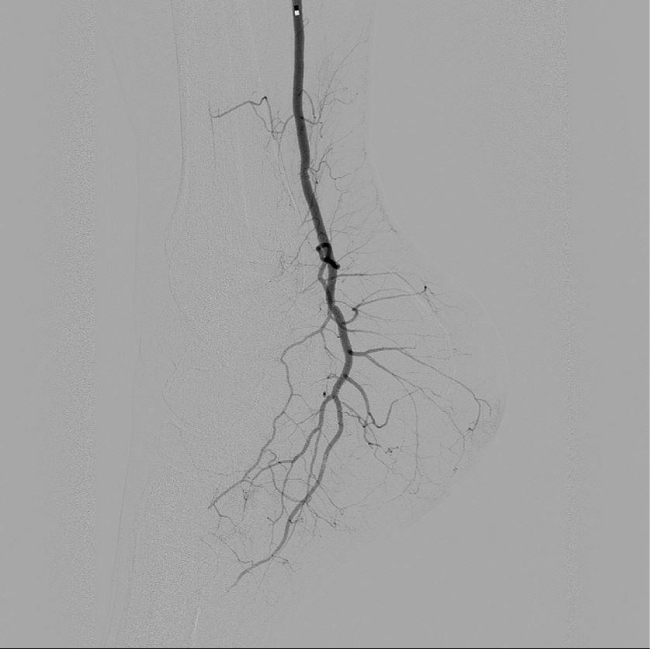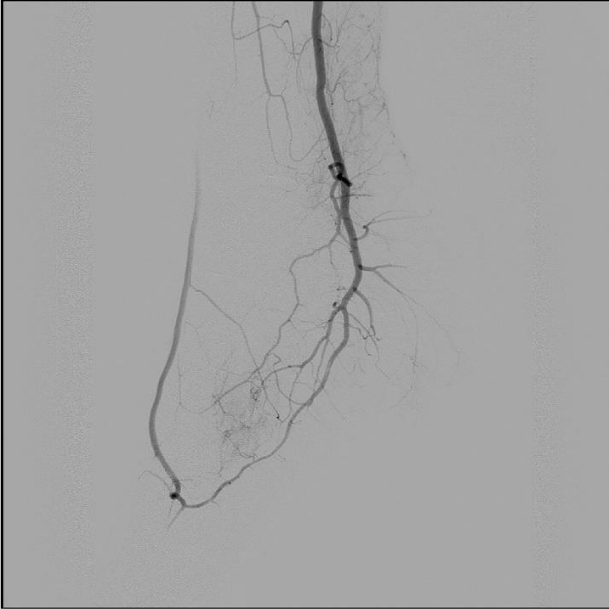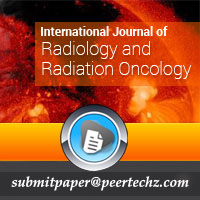International Journal of Radiology and Radiation Oncology
Combination of Thrombolysis and Glycoprotein IIb/IIIa Inhibition in Chronic Peripheral Thrombosis: A Case Report
Mubin I Syed1-3,5, Ryan Gallagher3, Zeshan Hussain4*, Azim Shaikh1, Philip J Cain5, Kamal Morar1-3,5, Matthew Sebastian1-3,5, Robert Tyrrell1-3,5, Allen Guehl5 and Ronald Erdelyi3
2Good Samaritan Hospital, 2222 Philadelphia Dr., Dayton, OH 45406, USA
3Boonshoft School of Medicine at Wright State University, 3640 Colonel Glenn Hwy, Dayton, OH 45435, USA
4Stanford University, 450 Serra Mall, Stanford, CA 94305, USA
5Springfield Regional Medical Center, 100 Medical Center Drive, Springfield, OH 45504, USA
E-mail: mubinsyed@aol.com
Cite this as
Syed MI, Gallagher R, Hussain Z, Shaikh A, Cain PJ, et al. (2017) Combination of Thrombolysis and Glycoprotein IIb/IIIa Inhibition in Chronic Peripheral Thrombosis: A Case Report. Int J Radiol Radiat Oncol 3(1): 004-006. DOI: 10.17352/ijrro.000020Currently, many interventionalists employ either tissue plasminogen activator (alteplase, Genentech, San Francisco, CA), or recombinant plasminogen activator (reteplase, Chiesi USA, Inc., Cary, NC), for peripheral thrombolysis. Further, combination therapy utilizing a thrombolytic agent and a glycoprotein IIb/IIIa receptor antagonist has been proposed as a way to overcome the limitations of thrombolytic therapy alone by reducing the duration of infusion, preventing rethrombosis, and improving the efficacy of thrombolysis. The following report discusses a patient with stenoses in the distal right posterior tibial artery. The patient underwent percutaneous transluminal angioplasty along with tissue plasminogen activator infusion therapy. Initially, the tissue plasminogen activator infusion reduced pain. However, an embolic occlusion to the distal right lateral plantar artery led to recurrence of pain. Due to failure of thrombolytic monotherapy using tissue plasminogen activator, a combined treatment of eptifibatide (Integrilin, Cor Therapeutics and Schering-Plough) and tissue plasminogen activator infused intra-arterially was initiated. In this report, the successful clinical use of combination therapy has been demonstrated after failed intra-arterial tissue plasminogen activator infusion monotherapy. The use of purely intra-pedal intra-arterial eptifibatide is novel and should be studied in randomized trials to establish efficacy. Furthermore, we have shown that failure of monotherapy to treat occlusions can be recovered through the use of combination therapy.
Introduction
Endovascular treatment is commonly used for patients with peripheral arterial disease and symptomatic limb ischemia. Percutaneous transluminal angioplasty, stent placement, thrombolysis, and thrombectomy are among the wide range of treatments performed. Currently, many interventionalists employ either tissue plasminogen activator (tPA) or recombinant plasminogen activator (rPA) for peripheral thrombolysis. In large-scale prospective randomized controlled trials for acute myocardial infarction (Global Use of Strategies to Open Occluded Coronary Arteries III or GUSTO-III, and Randomized Phase II Study To Expedite Allogeneic Transplant With Immediate Haploidentical Plus Unrelated Cord Donor or RAPID-II), the two drugs appear to be equally safe and effective when used systemically [1,2]. Further, combination therapy utilizing a thrombolytic agent and a glycoprotein (GP) IIb/IIIa receptor antagonist has been proposed as a way to overcome the limitations of thrombolytic therapy alone by reducing the duration of infusion, preventing rethrombosis, and improving the efficacy of thrombolysis. GP Iib/IIIa antagonists act to prevent platelet aggregation which contributes to acute thrombus formation and distal platelet thromboembolism. Both the Global Use of Strategies to Open Occluded Coronary Arteries V (GUSTO V) and the Strategies for Patency Enhancement in the Emergency Department (SPEED) trials for acute myocardial infarction showed improved outcomes with combination therapy using a low-dose thrombolytic plus abciximab compared to a thrombolytic alone [3,4]. The results of a pilot study that retrospectively evaluated reteplase and abciximab in peripheral arterial occlusion have also suggested that shorter infusion times are associated with minimal complications [5]. The GP Iib/IIIa antagonists currently available are abciximab, eptifibatide, and tirofiban. The following report discusses a 52 year-old man presenting with two tandem critical tenosis within the distal right posterior tibial artery. The patient underwent percutaneous transluminal angioplasty along with tPA infusion therapy. Initially, the tPA infusion reduced pain and tenderness. However, an embolic occlusion to the distal right lateral plantar artery led to recurrence of pain and cyanosis of the right lateral foot, after two days. Due to failure of thrombolytic monotherapy using tPA, a combined treatment of eptifibatide (Integrilin, Cor Therapeutics and Schering-Plough) and tPA infused intra-arterially was initiated.
Case Report
The patient, a 52 year-old-male, underwent a 9 mm diameter covered stenting of the right common iliac artery critical stenosis on 1/15/14. This procedure showed symptomatic improvement of cyanosis of the toes and the sole of his right foot as well as tenderness of his right foot. The patient reported being able to walk as far as he wished continuously whereas previously he could only walk between 15-20 feet before having to rest. Soon thereafter, however, the patient complained of resumed intermittent pain involving the ball of his right foot as well as to a lesser extent within the lateral aspect of his right forefoot. Upon hospitalization on 3/13/14, he underwent 3 mm percutaneous transluminal angioplasty of two tandem critical stenoses within the distal right posterior tibial artery in the region of the ankle joint along with catheter-directed tPA infusion therapy into the distal right posterior tibial artery (for an embolic occlusion of the distal right lateral plantar artery). Although the patient initially recovered from the pain (that had not been resolved by the aforementioned covered stenting of the critical stenosis within the right common iliac artery), there was persistence of the embolic occlusion to the distal right lateral plantar artery even after overnight catheter-directed tPA infusion. Because the patient was symptomatically improved the next day after the procedure, this occlusion was not intervened upon. However, two days later, the patient developed pain within his right lateral foot with associated cyanosis and tenderness. The right distal lateral plantar artery distribution was associated with decreased capillary refill. He was unable to work due to pain while walking and resting. Subsequently, he was admitted for reintervention on 3/28/14. Antegrade access was obtained to the right femoral artery (previously contralateral retrograde access was obtained to facilitate the ipsilateral antegrade access). Next, a 0.035 inch Quick Cross catheter (Spectranetics, Colorado Springs, CO) was negotiated into the distal right posterior tibial artery over a standard 0.035 inch angled tip glide wire. It was then decided to infuse a bolus of Integrilin as a weight based bolus, 6.8 ml at a concentration of 2 mg/ml. This was followed by tPA 2 mg in 10 ml of normal saline. At the start of the case, the patient had been given heparin 5000 units intravenously with an ACT of 192 seconds. After the intra-arterial Integrilin and tPA was infused into the distal right posterior tibial artery, there was a marked angiographic improvement of the distal branches. In fact, there was patency of the entire distribution of the right lateral plantar artery such that it communicated with the dorsalis pedis artery through the plantar pedal loop. Note was also made of excellent patency of the distal branches of the medial plantar artery as well. The patient reported marked relief of his pain immediately. Based on this, it was decided to terminate the procedure. Comparative views of the right posterior tibial artery after overnight tPA infusion alone (Figure 1) and following the addition of an intra-arterial bolus of Integrilin (Figure 2) are shown. Prior to discharge and at follow up 11 days after the procedure, the patient reported that he was able to walk as far as he wished. Previously, he could only walk a short distance before he developed severe pain in his right foot that would require him to stop. He reported that his symptoms were “98% improved”. His Oswestry Disability Index improved from 28% to 11%. On physical exam the ischemic mottling of the skin in the right lateral foot had resolved.
Discussion
In summary, upon identifying two tandem critical stenoses within the distal right posterior tibial artery in the region of the ankle joint, the patient underwent 3mm percutaneous transluminal angioplasty along with overnight tPA infusion therapy into the distal right posterior tibial artery. Initially, the overnight tPA infusion therapy improved pain and tenderness. However, evidence of an embolic occlusion to the distal right lateral plantar artery even after the tPA infusion led to recurrence of tenderness, pain, and cyanosis of the right lateral foot. Following failure of thrombolytic monotherapy using tPA, a combined treatment of eptifibatide, a glycoprotein IIb/IIIa inhibitor, and tPA was utilized. The eptifibatide and tPA were infused intra-arterially into the distal right posterior tibial artery. Several reasons, including evidence from previous trials as well as the biochemistry of the clotting mechanism, contributed to our use of combination therapy as opposed to another form of monotherapy. Firstly, according to a report by Ouriel that addressed combination GPIIb/IIIa inhibitors with thrombolytic therapy, there was data suggesting that the risk of hemorrhagic complications was directly proportional to the length of treatment [6]. Thus, it was important to decrease the time of administration of thrombolytic therapy. Unfortunately, the use of intra-arterial thrombolytic agents was correlated with infusion over a relatively long period of time, sometimes over 24 hours. This was likely because lysis of the occluding thrombus was dynamic, with the dissolution of the initial thrombus being replaced with new thrombus. Platelets, which formed a network along with fibrin and surround erythrocytes, played a direct role in this rethrombosis. Therefore, using an antagonist in the form of a GP IIb/IIIa inhibitor to target the platelets as well as a main thrombolytic agent to target fibrin was expected to minimize the treatment time to effectively dissolve the clot. Previous trials that used a combination of thrombolytic agents and GP IIb/IIIa inhibiting drugs showed significant reduction in secondary complications such as recurrent ischemia and urgent revascularization. In an initial pilot study done by Drescher et al., a combination of reteplase and abciximab was used to treat peripheral arterial occlusions. They reported that combination therapy was a viable, alternative treatment due to a significant lowering of thrombolysis time and minimal adverse effects. Fourteen of the 15 patients showed complete thrombolysis while the remaining patient had a major amputation. However, because of the small sample size, the conclusions derived from these results should be used with caution [5]. In the GUSTO V randomized trial, Topol et al., compared the effects of reteplase alone with reteplase in addition to abciximab in patients with acute myocardial infarction. The large sample size of this trial (n=16588) as well as the classification of endpoints (primary endpoint: 30-day mortality, secondary endpoint: MI complications) suggested more reliable results. Although the combined reteplase plus abciximab group was not found to be strictly superior to the reteplase-only group, the combined treatment had a 0.3% absolute (5% relative) decrease in 30-day mortality, which fulfilled the criteria of non-inferiority (GUSTO V) [3]. The benefit of combining a thrombolytic with a GP IIb/IIIa inhibitor, particularly the specific thrombolytic combination used in our case, was suggested by Yoon’s comparison of 17 patients who received eptifibatide and tPA with a group of patients who received only tPA. Those patients who received an intra-arterial dosage of eptifibatide required a significantly smaller dosage of tPA for successful thrombolysis [6]. The brunt of these previous studies showed that one of the main advantages of using a combination therapy of a thrombolytic agent with a specific GP IIb/IIIa inhibitor was a significant reduction in treatment time as well as dosage. This is particularly advantageous because it directly leads to a reduction in hospital costs as well as usage of hospital resources. In some cases, combination therapy shows a decrease in secondary complications such as recurrent bleeding and urgent revascularation. Eptifibatide was chosen for use in our patient based on evidence of its safety, efficacy, and cost. Several studies have found that the use of intra-arterial eptifibatide was a viable and safe option for reocclusion and thrombolysis of distal inaccessible thrombi and has been linked to improved clinical outcomes [7,8]. Eptifibatide was also found to have the lowest average per-patient treatment cost of available GP IIb/IIIa antagonists based on use in coronary syndromes [9]. The established safety and lower cost of eptifibatide as compared to other GP IIb/IIIa antagonists provided support for its use in combination therapy. Returning to the case, perfusion of the distal right lateral plantar artery (intra-pedal) after infusion of both intra-arterial eptifibatide and tPA were quite improved. Occlusion of this artery responded successfully to treatment, and there was a noticeable angiographic improvement of the distal branches. In fact, there was patency of the entire distribution of the right lateral plantar artery such that it communicated with the dorsalis pedis artery through the plantar pedal loop. In this report, we have shown successful clinical use of combination therapy, specifically the use of intra-arterial eptifibatide with tPA after failed intra-arterial tPA infusion monotherapy. We believe that the use of purely intra-pedal intra-arterial eptifibatide is novel and should be studied in randomized trials to establish efficacy. Furthermore, we have shown that failure of monotherapy to treat occlusions can be recovered through the use of combination therapy.
- (1997) A comparison of reteplase with alteplase for acute myocardial infarction. The Global Use of Strategies to Open Occluded Coronary Arteries (GUSTO III) Investigators. N Engl J Med 337: 1118-1123. Link: https://goo.gl/XQMgi4
- Bode C, Smalling RW, Berg G, Burnett C, Lorch G, et al. (1996) Randomized comparison of coronary thrombolysis achieved with double-bolus reteplase (recombinant plasminogen activator) and front-loaded, accelerated alteplase (recombinant tissue plasminogen activator) in patients with acute myocardial infarction. The RAPID II Investigators. Circulation 94: 891-898. Link: https://goo.gl/181zle
- Topol EJ (2001) Reperfusion therapy for acute myocardial infarction with fibrinolytic therapy or combination reduced fibrinolytic therapy and platelet glycoprotein IIb/IIIa inhibition: the GUSTO V randomised trial. Lancet 357: 1905-1914. Link: https://goo.gl/N8bZv6
- (2000) Trial of abciximab with and without low-dose reteplase for acute myocardial infarction. Strategies for Patency Enhancement in the Emergency Department (SPEED) Group. Circulation 101: 2788-2794. Link: https://goo.gl/IHsbS7
- Drescher P, Crain MR, Rilling WS (2002) Initial experience with the combination of reteplase and abciximab for thrombolytic therapy in peripheral arterial occlusive disease: a pilot study. J Vasc Interv Radiol 13: 37-43. Link: https://goo.gl/ddyjcr
- Yoon HC, Miller FJ Jr. (2002) Using a peptide inhibitor of the glycoprotein IIb/IIIa platelet receptor: initial experience in patients with acute peripheral arterial occlusion. Am J Roentgenol 178: 617-622. Link: https://goo.gl/HUduHL
- Memon MZ, Natarajan SK, Sharma J, Matthews MS, Snyder KV, et al. (2011) Safety and feasibility of intraarterial eptifibatide as a revascularization tool in acute ischemic stroke. J Neurosurg 114: 1008-1013. Link: https://goo.gl/wDulUa
- Mahmoudi M, Delhaye C, Wakabayashi K, Torguson R, Xue Z, et al. (2011) Integrilin in patients undergoing primary percutaneous coronary intervention for ST-elevation myocardial infarction. J Interv Cardiol 24: 351-356. Link: https://goo.gl/z8oYiA
- Shahriar J, Shaw JW, Malone D (2001) Cost effectiveness analysis of abciximab, eptifibatide and tirofoban in patients with coronary syndromes. Value Health 4: 102. Link: https://goo.gl/w8GOwV
Article Alerts
Subscribe to our articles alerts and stay tuned.
 This work is licensed under a Creative Commons Attribution 4.0 International License.
This work is licensed under a Creative Commons Attribution 4.0 International License.



 Save to Mendeley
Save to Mendeley
